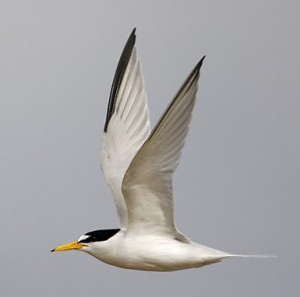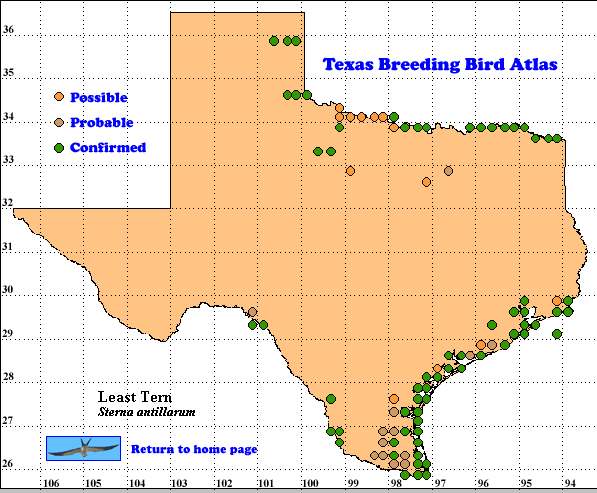Least Terns, the smallest of North American terns, are very similar in plumage to at least 7 other species of small terns from other parts of the world (Thompson et al. 1997, Am. Ornithol. Union 1998). Least Terns breed, mostly colonially, in a variety of habitats and have adapted to nesting on gravel roofs. Here the breeders have to contend with high temperatures, but are relatively safe from ground predators. These terns feed themselves and their chicks on small fish. Least Terns search for prey while flying or hovering 1–10 m (3-33 ft) above water, similar to methods used by other tern species. When a fish is spotted they quickly plunge to the water’s surface, but do not fully submerge. They usually grasp their prey with their open bills, then rise well above the water to manipulate and swallow the fish in flight or carry it to their chicks (Thompson et al. 1997).
DISTRIBUTION. During the 1987-1992 field work seasons of the TBBA project, volunteers found 197 confirmed, 31 probable and 43 possible breeding sites for Least Terns, primarily along or near the coast, the Red River and the Rio Grande River east of the 101st meridian. North American Breeding Bird Survey (BBS) data show Least Terns present along the coast at relative abundances of 1-3 terns per 40 km (25 mi) route (Sauer et al. 2008). In Oklahoma, atlasers found confirmed breeding in 4 assigned blocks and 4 probable sites in blocks as well as nests in 8 other areas, scattered across the state (Byre 2004).
BBS data show Least Terns present in breeding season along the Atlantic and Gulf coasts from New England to Texas. Another population breeds in the Mississippi River drainage upstream to Illinois and Nebraska (Sauer et al. 2008). Breeding has also been reported further upriver on the Great Plains. An endangered subspecies breeds on the Pacific Coast from central California to southern Baja California. Least Terns also breed in mainland Mexico, Honduras and the West Indies. They winter in Mexico, Central America, the southern West Indies and northern South America (Stiles and Skutch 1989, Howell and Webb 1995, Thompson et al. 1997, Am. Ornithol. Union 1998).
SEASONAL OCCURRENCE. Least Terns arrive in the eastern two-thirds of Texas as uncommon to rare migrants between mid-March and mid-June. They breed from early April to early August, based on egg collection dates from April 9 to July 28. Fall migrants start departing in early July and are finally gone by mid-December (Oberholser 1974, Lockwood and Freeman 2004).
BREEDING HABITAT. Least Terns breed from near sea level to at least 800 m (2600 ft) in the eastern Panhandle (Oberholser 1974, TBBA). In Colorado Least Terns seem to prefer islands in irrigation reservoirs on the eastern plains (Nelson 1998). In areas relatively free of vegetation and above high water levels, the tern pair makes several scrapes by sitting on sand, soil or pebbles and kicking out material. The scrape may be lined with light-colored pebbles or shell fragments. Within 2 days of nest completion the female usually lays 2-3 smooth, dull, beige to light olive brown eggs, with spots or speckles of dark brown or black. These are laid at one day intervals. Both sexes incubate the eggs for a total of 19-25 days (Thompson et al. 1997). This reference contains photos of nests, eggs and young birds. Newly hatched chicks are brooded by parents for 1-2 days and fed small fish until after their first flight at about 20 days after hatching. Then they weigh about 90% of adult mass. Most Least Terns begin breeding in their third year and raise one brood per year. They can renest rapidly if eggs or chicks are lost (Thompson et al. 1997).
STATUS. Least Terns are common summer residents along the coast and rare to locally uncommon at scattered locations inland (Lockwood and Freeman 2004). Although breeding distribution along the Texas coast is similar on the TBBA map and that in Oberholser (1974), the latter shows far fewer records along the Red River, suggesting population growth there. BBS trend data for Texas is derived from only 7 routes and is not statistically significant, but North American data from 64 routes suggests little annual population change for the 1980-2007 period (Sauer et al. 2008).
Two of the three populations of Least Terns (Interior and California) are federally listed as Endangered. The Atlantic and Gulf coast population is not federally listed. However there are no clear morphological or genetic distinctions among subspecies and chicks banded on the Texas coast have been found later breeding in Kansas (Thompson et al. 1997) Because of the lack of distinction between populations and movement between breeding areas, the status of this species in Texas deserves careful monitoring.
Text by Robert C. Tweit (2008)
Literature cited.
American Ornithologists’ Union. 1998. Checklist of North American birds, 7th ed. Am, Ornithol. Union, Washington, DC.
Byre, V. J. 2004. Least Tern (Sterna antillarum). In Oklahoma breeding bird atlas, pp. 158-159 (D. L. Reinking, ed.). University of Oklahoma Press, Norman.
Harrison, H. H. 1979. A field guide to western birds’ nests. Houghton Mifflin, Boston, MA.
Howell, S. N. G. and S. Webb. 1995. A guide to the birds of Mexico and northern Central America. Oxford University Press, New York.
Lockwood, M. W. and B. Freeman. 2004. The TOS handbook of Texas birds. Texas A&M University Press, College Station.
Nelson, D. L. 1998. Least Tern (Sterna antillarum). In Colorado breeding bird atlas, pp. 190-191 (H. E. Kingery, ed.), Colorado Bird Atlas Partnership, Denver.
Oberholser, H. C. 1974. The bird life of Texas. University of Texas Press, Austin.
Sauer, J. R., J. E. Hines, and J. Fallon. 2008. The North American breeding bird survey, results and analysis 1966-2007. Version 5.15.2008. USGS Patuxent Wildlife Research Center, Laurel MD < http://www.mbr-pwrc.usgs.gov/bbs>
Stiles, F. G. and A. F. Skutch. 1989. A guide to the birds of Costa Rica. Cornell University Press, Ithaca, NY.
Thompson, B. C., J. A. Jackson, J. Burger, L. A. Hill, E. M. Kirsch and J. L. Atwood. 1997. Least Tern (Sterna antillarum), The Birds of North America Online (A. Poole, Ed.). Cornell Lab of Ornithology, Ithaca, NY. Retrieved from: http://bna.birds.cornell.edu/bna/species/290

